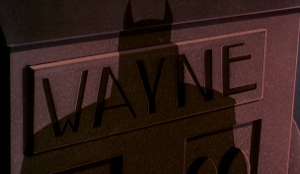
This is more than a good movie: it’s the movie I watch at least once a year to remind myself why I watch movies. Produced by the same writers, directors, composers and cast as Batman: The Animated Series, Mask of the Phantasm is not only the best superhero movie of the 1990s, its easily the gold standard by which to judge all subsequent superhero films.
Shame the thing isn’t better-known outside of the fan community. It’s unique among superhero movies of its age, both for its faithful importation of material already present in Batman comics and for its deft incorporation of new story elements that add depth and meaning to the source, reinforcing key themes without hitting the audience in the face with some overriding Message or a lot of heavy Exposition. Arguably the most mature American cartoon feature to date, it deals with grand questions of fate, free will and the psychological cost of living in the shadow of one’s past. Plus…it’s frickin’ Batman. Honestly, what’s not to love?
Like all the best episodes of the animated series, Phantasm begins with a mystery for Batman (Kevin Conroy) to solve in the deaths of several prominent Gotham City mobsters, and since the killer (who goes unnamed for the entire film) is also a costumed vigilante with a flare for the dramatic and a love of capes and cowls, the entire city believes Batman’s finally blown his last gasket.
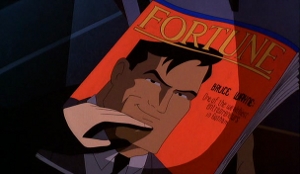
Meanwhile, one of Bruce Wayne’s old flames, Andrea Beaumont (Dana Delany), returns to Gotham after an unknown amount of time abroad. Through a series of flashbacks intercut with the man action (nicely bracketing each act) we learn “Andy” was the last real emotional connect Bruce allowed himself before he became Batman full time. Eventually, we see Bruce’s relationship with Andy was instrumental to this decision, and these flashbacks add more psychological complexity to Bruce Wayne than any film before or since, no joke, full stop.
These days, whenever I tell people about Mask of the Phantasm I’m force to describe it as “Batman Begins twelve years before Batman Begins,” which always makes me pause to wonder “What in the hell was the point of those twelve years?” Before we get into that, consider this a blanket spolier warning. Mask of the Phantasm is a mystery, and since its a mystery I like I’m going to get all the praise out of the way before I actually discuss it.
All you really need to know is, everything in this movie works. The story is well-paced, tightly-written and constructed to draw you in no matter your level of familiarity with the character. Say you come from Mars and have no idea who Batman is: this movie answers with a flashback to his origin story. Say you’re an old hand at Batman mythology; the movie gives you fights, car crashes, chase scenes, Batman showcasing actual Detective skills and (eventually) the Joker. I have minor quibbles with a few points, but they are inconsequential next to the towering monuments of awesomeness dotting Mask of the Phantasm‘s landscape.
Instead of doing anything cute with my site’s code or filling this post with a bunch of empty space I’m just going to stick the rating here. If you haven’t seen this movie, do. In fact, buy multiple copies and pass them out to all your friends and family. When you’re done, come back and find out why I’ll go to my grave insisting Phantasm is the unassailable height of American superhero film.
![]()
![]()
![]()
![]()
![]()
There. Now I won’t have to remember to do that later…
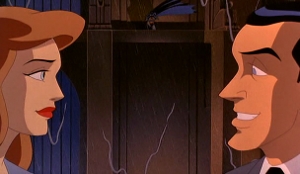
Back yet? Wasn’t that awesome? The real shame is, Mask of the Phantasm bombed at the box office during its initial run in theaters, only making its money back once those of us who missed its Christmas debut received it for our birthdays throughout 1994. This is why all subsequent DC Animated features have gone direct-to-video (direct-to-DVD now), and I can’t help but think back and wonder what the 90s might’ve looked like had this film been the hit it rightly deserved to be.
Unlike Tim Burton’s Batman films, this one takes the revolutionary approach of actually being about Batman. His backstory, motivations and character bits are all integral to the plot in so far as the plot forces him to reexamine key moments of his own life. The choices he made in order to live the masked vigilante’s life, and the personal toll those choices have taken on him, become all too clear thanks to the actions of Andrea Beaumont…who’s the Phantasm, of course.
I don’t say “of course” to be glib or funny. My fellow nerds and I were well-used to seeing Love Interests become Villains, even back then. Rarely are love interests such good foils for their protagonist, and rarer still are villains presented with as much understanding and sympathy. Andrea is no stock character who exist only to be rescued: she’s the driving force of this entire narrative from the word go. But rather than make this the film’s end-all Alan Burnett, Paul Dini, Michael Reaves and Martin Pasko use her to hold up a mirror for Bruce.
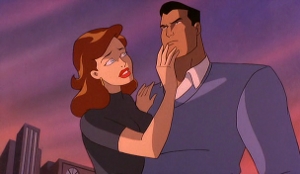
Three great scenes establish the entire character of their relationship, and it’s fitting all three take place in the same graveyard. Young Bruce first meets Andy at his parent’s grave because her mother happens to have a plot just down the row. The two haunted, rich, young Gothamites click instantly, stirring up Young Bruce’s central internal conflict. He goes back to the graveyard and (in the best scene of any Batman movie to date) begs his dead parents to let him out of his vow as an Ominous Thunderstorm swells, providing his only answer…until Andrea appears to bring him out of the rain.
Nothing symbolic about that, eh? Of course their relationship is doomed. If we didn’t already know that the film reinforces it by restaging Bruce and Andrea’s original meeting in the film’s “present.” In the past they met on a sunny afternoon. Now it’s night and Batman, his investigation temporarily stymied, wanders over to the Wayne headstone to pay his respects…only to find Andrea exactly as she was, all those years ago, still talking to her dead mom. “Sorry, Mom,” Andrea says, “but the whole world’s gone to seed.”
Viewers of the Series will recognize this at once. The entire, timeless, German Expressionist nightmare that is Gotham City seems to reflect this. Batman’s world is certainly “seedier” than most superhero’s but it’s not a forced seediness, intent on being “hip” or “edgy,” it’s an essential reflection of his interior conflicts. Thanks to past personal tragedy, Batman lives in a seedy underworld where the sky is either red or black and happy endings dare not walk. And since Andrea’s now walks in that same world, she can recognize Bruce right through his cape and mask.
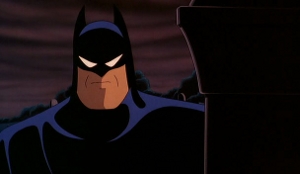
Andrea (we learn, once again in flashback) made the same choice as Bruce once circumstances, meaning the mob, left her with no other options. Meaning they killed her father – whose failed scheme to embezzle from exactly the wrong kind of people necessitated Andrea depart Bruce’s life with no explanation. This, in turn, left him with no options (or so he thought) besides the one he’d already decided upon before Andrea cocked things up. This leads to a wonderful scene (that should’ve been in Batman Begins) where Bruce suits up for the first time and Alfred (the peerless Efrem Zimbalist Jr.) is so shocked by the transformation he takes the Lord’s name in vain (a serious no-no in American animation of the time).
Alfred’s shocked by the lengths his employer, friend, and surrogate son has gone to in order to fulfill that damned vow. But for all his glowering and bataranges, Bruce never kills anyone, and here’s where the character of Andrea Beaumont really shines. She is one of the best sociopathic, vigilante anti-heroes I’ve ever seen. Like Bruce but unlike Frank Castle or Wolverine, she’s a conflicted, sympathetic human being with enough intelligence to see revenge for the dead-end path it is…she’s just past the point of giving a shit. Again, like Bruce, Andrea’s tragically flawed because she’s resigned herself to fate. Ironically, by growing closer to Bruce Wayne than arguably anyone in the character’s history, Andrea ensures they can never live happily ever after.
In flashback, we see young Bruce repeatedly choose the daylight world of sun and fun times with her…only to be pulled back by the dictates of his vow and strange coincidences that might be interpreted as Fate’s Visible Hand. There’s a sense of impending doom hanging over even the brightest sequence in The Bruce and Andrea Show: their date to the Gotham’s City of the Future exhibit/theme park. Aside from being a great homage to Fritz Lang, the sequence also becomes bitterly ironic when we see the City of the Future again in the film’s “present.” The park, a symbol of the optimistic hopes Bruce and Andrea might’ve harbored, has decayed into a grime-encrusted hellscape by the time Bruce and Andrea meet again, a rusted, disgusting parody of its former self.
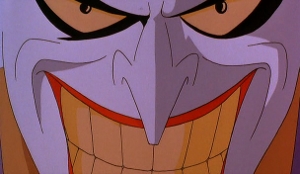
So, fittingly enough, the Joker’s retrofitted the whole park into his latest hideout, which certainly comes in handy when the film needs a grand stage for its climactic action sequence…featuring, among other things, Batman and the Joker going at it in scale model of the City of the Future, recalling all the giant monster movies you and I know and love. In any other film the Joker’s presence would feel forced, an obligatory nod to audience expectations and an early example of Villain Squeezing, which hampers superhero sequels to this day. Instead, the film finds a way to make the Joker’s presence a logical, organic plot complication, an essential part of film’s whole. He’s the personification of all the chaotic forces that twisted Bruce’s and Andrea’s lives into their present shape. He’s also a living answer to the question Batman asks Andrea once he confronts her with everything he knows: “What will vengeance solve?”
Nothing. In the long run, it usually just makes things worse, and Batman is the character he is because he struggles with this on a nightly basis (as Alfred presciently mentions). And for all his bluster (“I am vengeance!” he once told a Scarecrow-inspired hallucination in the Series), Batman’s crusade is a proactive one. Not for personal revenge – it’s too late for that, and he knows no amount of unconscious criminals will ever bring Thomas and Martha Wayne back. But if beating bad guys to a bloody pulp will keep just one other little boy or girl from having to see the kind of shit Bruce saw, then beat them to bloody pulp he shall.
Andrea’s stuck in a reactive mode. All she can think to do is kill those who’ve killed her future. Bruce moved past that ages ago, if he ever went there, and realized that proactive superhero daring-do really can help to sooth the soul. Sure, there are those times when your old girlfriend comes back to town and decides to become a supervillain, but…hey, can’t win ’em all. Batman’s fight is not the kind you win: it’s the kind you sacrifice your personal happiness for. It’s the kind of fight you fight in the name of “the greater good.” That’s why we call it “heroism” children, and Mask of the Phantasm is an unflinching examination of heroism’s pitfalls, dark sides…and promises.
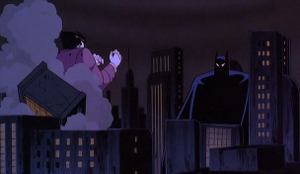
With all that going for it, why doesn’t Mask of the Phantasm get due props? As far as the American moviegoing public’s concerned, Mask has three major strikes against it: previous expectations, lack of marketing, and simple audience stupidity. Many a parent complained that 1992’s Batman Returns was “too dark” for their children. Meaning it was “too dark” for them. Their kids begged to see a superhero film and, when they got to the theater, parents found an unapologetic Tim Burton film waiting for them, like an evil Jack in the Box. I imagine it was akin to finding out this year’s hot new toy is actually a poisonous spider with a salacious picture of Michelle Pfeiffer in black leather jammies taped to its back.
To many, this felt like a bait and switch. My grandparents, for example, paid for my cousins and I to see Returns on its opening weekend. We were nine at the time and we loved every creepy-ass minute of it. They very much didn’t. Thinking themselves wise to Warner Brother’s game, other Parental Units probably turned their kids down when little Johnny and Janey began clamoring to go see Mask of the Phantasm.
That’s assuming their kids heard about it at all, a dubious assumption at best. With films like Tombstone, What’s Eating Gilbert Grape and Grumpy Old Men opening the same month on far, far more screens, Mask needed an add campaign to rival its live action predecessors. Undoubtedly, Warner Brothers balked at such a thing, fearing they’d be accused of seducing the innocent yet again by the same sets of chicken shit, pants-wetting parents who got Burton fired from the franchise. Twice in two years was too much for TimeWarner.
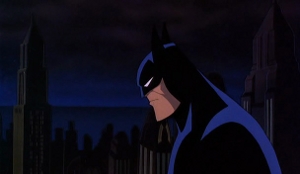
After all, it’s a superhero cartoon, yes…but in keeping with The Animated Series, it’s actually a tragic character-study wrapped in a murder mystery plot that just so happens to be animated…and just so happens to concern two people in fright costumes who fight crime…one of them with lethal force. Parents who’s children begged to see this rather than, say, Mrs. Doubtfire (for the third fucking time) probably took their kids to analysis. I got lucky. My parents took me to comic book stores.
If I were Batman, Mask of the Phantasm would be my dead parents: I love it, and I’ve made a vow to avenge its premature box office death. If one other person sees this film for the bit of genius it is, I’ll call that a vow fulfilled…but I won’t stop. I am, after all, vengeance. I am the night.
![]()
![]()
![]()
![]()
![]()

I was lucky enough to glimpse the end of what was probably the only TV commercial advertising MOTP. Even luckier was the fact that my town of 11, 000 had a theatre which actually ran this for a week. I took my 4-year-old son with me to see this ( we never missed an ep of BTAS after rushing home with him from his daycare) and the place was probably half-full. That’s pretty good for my lousy town and for a movie which had no marketing push. It’s been a long time, but I don’t remember any kids cutting up or other interruptions; plus this was before everyone had a cell phone. The audience seemed to really enjoy the movie and no kids got dragged out.
I’ve probably watched this a million times on video since then, and just recently purchased the limited edition extended soundtrack CD. Not sure why I think this movie is so damn cool. But it is. As much as I enjoyed “Batman Begins” and “Dark Knight”, this is still my definitive Batman movie.
It’s so damn cool because every element – acting, writing, directing, pacing, and especially Shirley Walker’s music – combine to form a whole more beautiful than any other superhero picture I’ve seen to date. It’s a perfect distillation of what Batman is, can and could be, the exact antithesis of Adam West’s TV farce. I’d say it should serve as the template for his subsequent features, but I know Hollywood interprets that phrase to mean “we should slavishly imitate its successful elements.” But hell, even if they did, the film would still stand as The Thing To Aim For, since it kicks so much ass it doesn’t even have time to note its lack of bubble gum.
Thank you for sharing your story. You and your son were part of this flicks five million dollar domestic take, something I only wish I could say about myself. Someone really should get a revival going now, since the film’s twentieth anniversary will be on us before we know it. And watching this thing on a forty foot screen would probably kick my ass so hard I’d wind up wearing it for a hat…an experience I’d hope everyone could share in.
“Arguably the most mature American cartoon feature to date”
Someone dosen’t know the work of Ralph Bakshi. 😛
Anyway, a fine review. For starters, this is my favorite portrayal of The Joker by far by any actor. Bruce Timm finally was allowed to show some bodies in The Joker’s name and his sadistic nature. I can’t help but recall Richard Widmark as Tommy Udo in the 1947 film noir classic, Kiss of Death.
Also unlike any other director before, or since, Bruce Wayne’s conflicted nature was finally well illustrated. I love his emotional break down when he dosen’t even know if he should persue his of vow of vengance now that he finally has found solace in his brooding world.
The conclusion is by far the most bitter of any Batman film. There is no real victory at the end of this film other than Bruce and Andrea’s lives being saved but their pain dosen’t end. The Joker won.
Au contraire mon frere, I loved Mighty Mouse: The New Adventures more than was probably healthy. In my defense, it kicked serious ass. As did the two seasons of that Spider-Man series Bakshi worked on in the ’60s, which was – believe it or not – the first Spider-Man-related media I ever encountered. Before Fox Kids…before the Ultimate universe…before Randy Hernandez In Space, my parents owned a convenience store and that store devoted one whole wall to renting out movies. Including the Transformers and G.I. Joe movies, Legend, Dark Crystal, and two tapes of Ralph Baskshi’s Spider-Man.
So we’re well-met, Bakshi and I. But he’s already burned me twice. This one time, he called it Cool World, and this other time he had the gall to call it Lord of the Rings but he stopped right at the end of Two Towers which was the worst kind of tease in the world. Rankin & Bass really won me over for life when they alleviated that case of cinematic blue balls.
Getting back to Gotham…I guess you could call that “winning.” Even though he lost one of the sweetest secret supervillain hideouts in history. Sure he was gonna blow it up anyway, but like all the best bombs it was aesthetically pleasing right up to the moment it went boom.
That’s another thing. It probably took a long time to get those twenty miles of explosives together. That probably represented years of hard labor, saved for those special occasions when regular reigns of terror just won’t do, like when Lex Luthor hires you to try and kill Superman.
I know Ralph made a lot of shit. Cool World wasn’t his fault and I know many hate his Lord of The Rings. I speak of his masterpieces such as Heavy Traffic, Coonskin, and Fritz The Cat. You don’t know Ralph’s work unless you have seen at least one of those films. Also his short lived HBO TV Show, Spicy City, is worth checking out.
As for the ending for MOTF, that’s an interesting rationale but it seem dosen’t much compared to destroying two peoples’ hope for a happy future. 😉
One last thing, I love the ending song “I never even told you”. Oh, I am so gay. Seriously, I am.
May I recommend under the red hood? I saw and it is quite good. Basically Ra’s hired the Joker to distract Batman but Joker went to far and murdered Robin. Now the Red Hood (I’d say spoilers but it’s kind of obvious) has returned (Jason was resurrected by Ra’s because Ra’s never intended for Jason to be murdered that senselessly) with the dual goals of taking down the Joker and surpassing batman. It’s dark brooding and although it doesn’t have the usual cast Bruce Greenwood and John Dimaggio really were suburb alternatives. It deals with the themes of guilt, and the difference between Batman and the Red Hood (The red hood is essentially batman if he crosses the line). The final confrontation at the end really drives home the difference.
I thought it was a lousy adaptation of a story that shouldn’t even have been done in the first place.
I didn’t even bother to watch Red Hood.
In fact, i didn’t even bother to read the whole original story, because it sucked dead moose.
Through a bendy straw.
Oo-ooh…controversy among my fellow Bat-fans. Let’s see if I can thread this needle without pissing all of you off in the process…be good practice for that review of Dark Knight I might or might not do in the future.
Under The Hood is a prime example of why I gave up following Batman comics and comics in general. Everything is always undermined or rebooted. I don’t care anymore. I only read what I’m interested in now.
I did like Jason reencacting the joker’s beatdown while mockingly asking the same one sided questions while joker has the “oh fuck” look
LOL This is great, you guys. Seriously. At this rate, I won’t even have to review the damn thing. Watching ya’all hash this out amongst yourselves is more entertaining for me anyway. You’ve accidentally, but very accurately, personified my own internal debates about the Red Hood saga, Jason Todd, and the plague of “reboot-itis” infecting modern superhero comics. It’s a glorious thing to see, really.
I would still appreciate it if you reviewed it
Then if this wasn’t enough, Barbra Gordon can walk again. Fuck you DC.
okay that was stupid
One of the things i loved about Mask (which you can’t mention to anyone who reads comics, because merely mentioning it is a massive spoiler) was that they essentially played a joke on the fanboy community, by taking basic plot elements of Batman: Year Two and turning them inside out.
So you could get all smug because you knew who the Phantasm was, and then at the Big Reveal, you went “Wait! What?!?”
Ha! An excellent point that should’ve been made, and I thank you for making it. Would that I’d read Year Two in the past twenty years…can you tell how much of an impression it left on me from the fact that I haven’t…? What am I sayin’; of course you can.